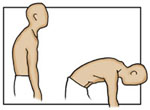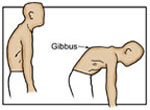Kyphosis
Spine Conditions:
Kyphosis
Kyphosis is the term used to describe an abnormal outward curvature of the spine. If severe, the condition can contribute to a “hunchback” appearance, and may require spine surgery for treatment.
What Is Kyphosis?
A certain degree of curvature is normal in the human spine. In fact, the gentle inward and outward curves of the neck, upper back and lower back are necessary for keeping the body properly balanced and aligned over the pelvis. Kyphotic curves are the outward curves; those that curve inward are called lordotic.
The term kyphosis is generally used to describe an excessive outward curve, or rounding, of the spine. Again, some kyphosis is normal –typically 20-50 degrees; curves greater than 50 degrees are considered abnormal. A spine with kyphosis can look normal, or it can develop a “humpback” appearance.
Mild kyphosis may cause few problems; however, severe kyphotic curvature can affect the lungs, nerves and other tissues and organs, causing pain and other problems.
There are several types of kyphosis, and the condition can be found in children, adolescents and adults.


Postural Kyphosis and Scheueremann’s Kyphosis
Postural kyphosis, or postural roundback, is the most common form of kyphosis and is often attributed to poor posture. Habitually “slouching” can stretch spinal ligaments and contribute to abnormal vertebral formation. The condition usually appears during adolescence, and is more common in girls than boys. Postural kyphosis is marked by a smooth, flexible curve that is not typically associated with pain, and usually doesn’t lead to problems later in life.
Scheueremann’s kyphosis most commonly develops in teenage boys. It is characterized by a short, sharp curvature in the middle part of the upper spine, and may be associated with aching back pain. This type of kyphosis tends to be rigid on clinical examination. A mild degree of scoliosis is common in adolescents with Scheueremann’s kyphosis.
Congenital kyphosis can be caused by a malformation of the spinal column during fetal development. Several vertebrae may be fused together or the bones may not form properly. This type of kyphosis may worsen as the child grows.

Disorders that can contribute to kyphosis in adults include:
- Osteoporosis, which can lead to vertebral compression fractures of the spine;
- Degenerative spinal conditions, such as arthritis
- Infections
- Tumors
- Spina bifida
- Paralytic diseases such as cerebral palsy and polio, which can stiffen the bones of the spine.
- Connective tissue disorders, such as Marfan syndrome
- Trauma
What Are The Symptoms Of Kyphosis?
The symptoms of kyphosis may include:
- Slouching posture or hunchback
- Mild back pain
- Spinal stiffness or tenderness
- Fatigue
In mild cases, kyphosis may produce no noticeable signs or symptoms.




